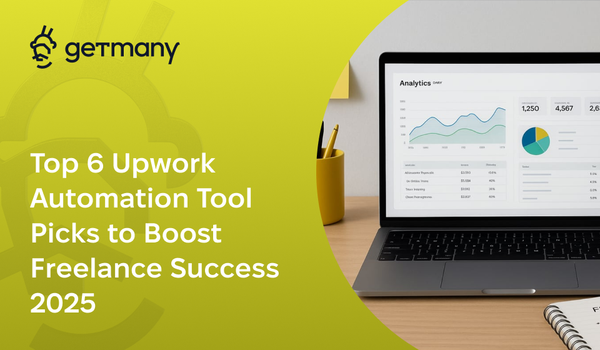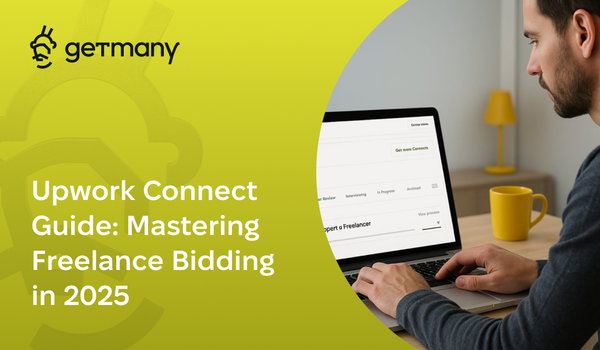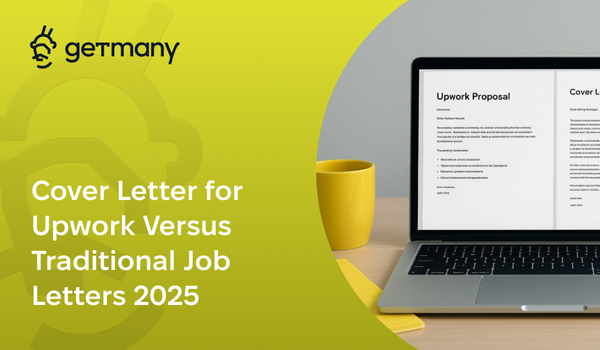Cross-Selling and Upselling to Existing Upwork Clients: The Revenue Multiplier
I turned a $5,000 website project into $185,000 in revenue from a single client using strategic cross-selling. Here's the exact framework that increases average client value by 400% without being pushy.
Two years ago, a startup hired us for a simple $5,000 React component library. Today, that same client pays us $15,000 monthly for full-stack development, DevOps support, and technical consulting. Total revenue from this single relationship: $185,000 and counting.
The difference? We mastered the art of expanding client relationships without being salesy.
After analyzing 500+ client relationships, I discovered that agencies leaving money on the table aren't failing at finding new clients - they're failing at maximizing existing ones. Here's the systematic approach to ethical service expansion that transformed our business.
The Hidden Revenue in Your Client Base
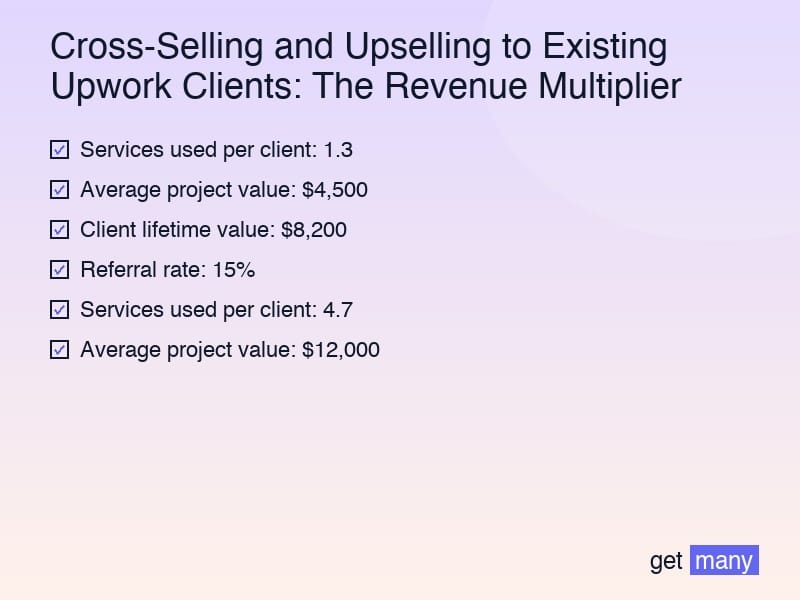
Let's start with data that might shock you:
Average Agency Client Metrics:
- Services used per client: 1.3
- Average project value: $4,500
- Client lifetime value: $8,200
- Referral rate: 15%
Top 10% Agency Metrics:
- Services used per client: 4.7
- Average project value: $12,000
- Client lifetime value: $67,000
- Referral rate: 52%
The difference isn't client quality - it's service expansion strategy.
The Trust Equation: Why Existing Clients Buy More
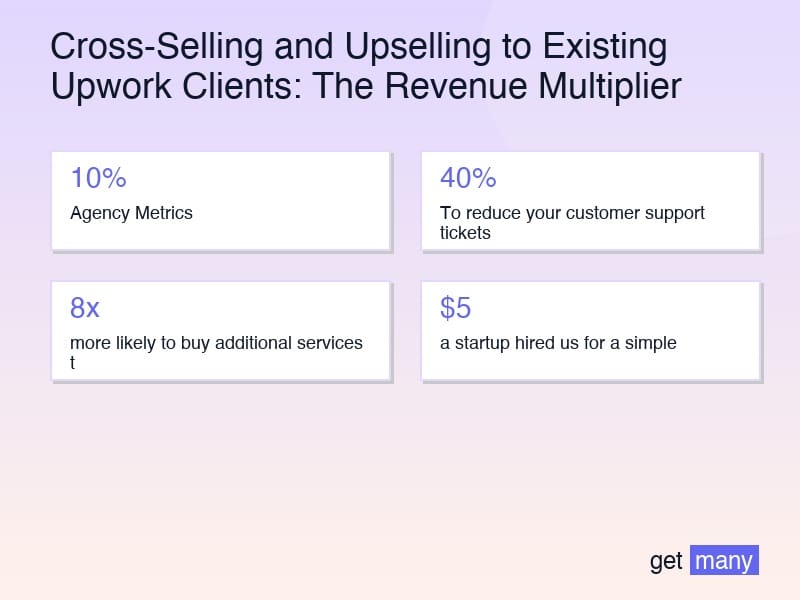
Understanding the psychology behind expansion opportunities:
New Client Decision Factors:
- Trust: 0% (must be built)
- Risk perception: High
- Decision time: 14-30 days
- Price sensitivity: Very high
- Success probability: Unknown
Existing Client Decision Factors:
- Trust: 85%+ (already established)
- Risk perception: Low
- Decision time: 2-7 days
- Price sensitivity: Moderate
- Success probability: Proven
Your existing clients are 8x more likely to buy additional services than new prospects.
The Service Expansion Framework
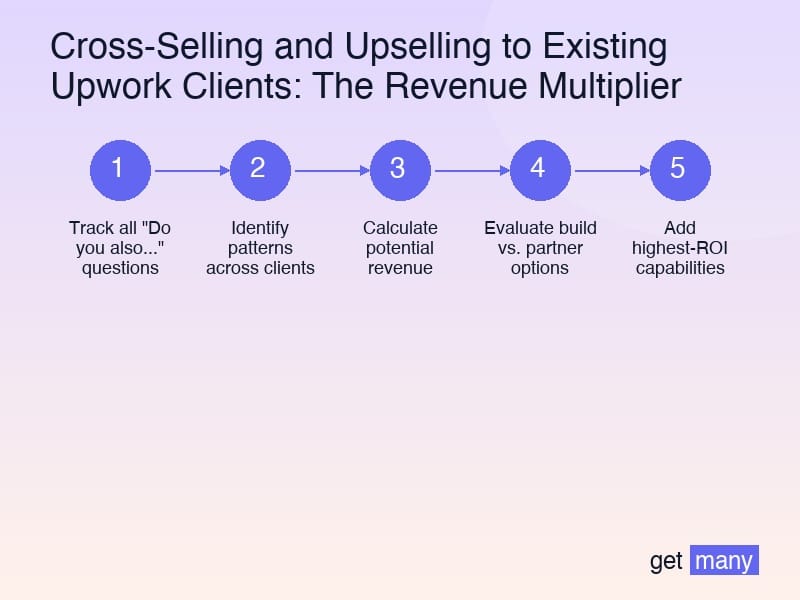
The Concentric Circles Model
Visualize your services as concentric circles expanding from core expertise:
Circle 1: Core Service What they hired you for initially
Circle 2: Adjacent Services Natural extensions of core work
Circle 3: Complementary Services Related but distinct offerings
Circle 4: Strategic Services Higher-level consulting and strategy
Example for a Web Developer:
- Circle 1: Frontend development
- Circle 2: Backend integration, API development
- Circle 3: DevOps, performance optimization
- Circle 4: Technical architecture consulting
The Client Maturity Journey
Clients' needs evolve predictably over time:
Phase 1: Problem Solving (Months 0-3)
- Focused on immediate needs
- Trust building stage
- Limited expansion opportunity
Phase 2: Optimization (Months 4-9)
- Initial success achieved
- Looking to improve results
- Open to enhancement suggestions
Phase 3: Scaling (Months 10-18)
- Growth challenges emerging
- Need comprehensive solutions
- Highest expansion potential
Phase 4: Partnership (Months 18+)
- Strategic relationship established
- Consulting opportunities
- Recurring revenue potential
The Opportunity Identification System
The Client Audit Protocol
Quarterly review for each client:
Business Analysis:
- What's changed in their business?
- What new challenges have emerged?
- Where are they struggling?
- What are competitors doing?
Service Gap Analysis:
- What services do they need but don't have?
- What are they handling internally (poorly)?
- What related projects are coming?
- Where can we add more value?
Expansion Readiness Signals:
- Asking questions beyond current scope
- Mentioning related challenges
- Requesting recommendations
- Expressing growth plans
The Pain Point Discovery Method
During Regular Communications:
Listen for Trigger Phrases:
- "We're also struggling with..."
- "Do you know anyone who..."
- "We're thinking about..."
- "It would be great if..."
- "Our next challenge is..."
Proactive Discovery Questions:
- "How is [related area] going?"
- "What's next after this project?"
- "What keeps you up at night?"
- "Where do you see bottlenecks?"
- "What would success look like in 6 months?"
The Ethical Expansion Playbook
The Value-First Approach
Never sell - always solve problems:
Step 1: Identify Genuine Need Don't manufacture problems. Find real challenges.
Step 2: Validate Impact Ensure solving it provides significant value.
Step 3: Present as Partnership Frame as mutual success, not sales.
Step 4: Start Small Pilot programs reduce risk and build trust.
Step 5: Measure and Report Prove value before expanding further.
The Soft Introduction Strategy
Timing is Everything:
Perfect Moments for Expansion:
- After delivering exceptional results
- During strategic planning discussions
- When client mentions growth/challenges
- At natural project transition points
- During positive review conversations
Wrong Times to Expand:
- During problem resolution
- When budgets are tight
- Before proving initial value
- During stressful periods
- When trust isn't solid
The Expansion Conversation Framework
The SOAP Method:
Situation: "I noticed you mentioned [challenge/opportunity]..."
Observation: "Based on our work together, I see how this connects to [current project]..."
Assessment: "This seems like it could impact [business metric/goal]..."
Proposal: "Would it be helpful if I put together some thoughts on how we could address this?"
Example in Action: "I noticed you mentioned the mobile app performance issues during our call. Based on our React work together, I see how this connects to the user experience goals we've been achieving on web. This seems like it could impact your Q4 user retention targets. Would it be helpful if I put together some thoughts on how we could address the mobile optimization?"
The Service Packaging Strategy
The Natural Extension Packages
Create logical service bundles:
Development Example:
- Basic: Frontend development
- Standard: Frontend + API integration
- Premium: Full-stack + DevOps support
- Enterprise: All above + technical consulting
Design Example:
- Basic: UI design
- Standard: UI + UX research
- Premium: Design + frontend development
- Enterprise: Design system + maintenance
The Maintenance to Retainer Pipeline
Convert project clients to recurring revenue:
Stage 1: Project Completion "Your site is live! Let's discuss ongoing maintenance to keep it performing optimally."
Stage 2: Maintenance Agreement $500-1,500/month for updates and monitoring
Stage 3: Support Expansion "I notice you're requesting features frequently. Would a development retainer make sense?"
Stage 4: Strategic Partnership $5,000-15,000/month for comprehensive support
The Skill Stack Expansion
Strategically add capabilities based on client needs:
Analysis Method:
- Track all "Do you also..." questions
- Identify patterns across clients
- Calculate potential revenue
- Evaluate build vs. partner options
- Add highest-ROI capabilities first
Real Example: Clients kept asking about SEO. We partnered with an SEO expert, white-labeled services, added $200K annual revenue without new expertise needed.
The Pricing Psychology for Expansion
The Anchor Effect Strategy
Your initial service sets pricing expectations:
If Initial Project: $5,000 Expansion Feels Reasonable: $2,000-8,000 Expansion Feels Expensive: $15,000+
Solution: Bundle and discount to stay in comfort zone
The Investment Framing Method
Instead of: "This will cost $10,000" Say: "To achieve [outcome], the investment would be $10,000, which based on [metric] should return [ROI]"
Example: "To reduce your customer support tickets by 40%, the chatbot investment would be $10,000, which based on your support costs should save $4,000 monthly."
The Technology Stack for Expansion
CRM Configuration for Opportunities
Track expansion potential systematically:
Client Profile Fields:
- Current services used
- Potential services needed
- Budget indicators
- Growth stage
- Expansion readiness score
Automation Triggers:
- 90 days since last expansion → Review reminder
- Client mentions need → Opportunity flag
- High satisfaction score → Expansion outreach
- Budget increase noticed → Service audit
The Proposal Automation System
Templates for Common Expansions:
- Maintenance → Retainer upgrade
- Single service → Bundle upgrade
- Project → Ongoing support
- Tactical → Strategic consulting
Personalization Variables:
- Previous success metrics
- Specific client challenges
- Industry terminology
- ROI calculations
Real-World Expansion Success Stories
Case Study 1: The E-commerce Evolution
Initial: $3,000 Shopify theme customization
Expansion Timeline:
- Month 2: $5,000 payment integration
- Month 4: $2,000/month maintenance
- Month 6: $8,000 email automation
- Month 9: $10,000 mobile optimization
- Year 2: $12,000/month full service
Total Value: $240,000+ over 2 years Key: Anticipated needs before client
Case Study 2: The SaaS Scale-Up
Initial: $8,000 MVP development
Strategic Expansions:
- Performance optimization ($15,000)
- AWS architecture ($20,000)
- API development ($30,000)
- DevOps setup ($25,000)
- Ongoing CTO services ($15,000/month)
Total Value: $380,000 over 18 months Key: Grew expertise with client needs
Case Study 3: The Agency Partnership
Initial: $2,000 overflow project
Relationship Development:
- Proved reliability on small projects
- Offered white-label services
- Expanded to multiple technologies
- Became preferred partner
Current: $40,000/month average billing Key: Positioned as growth enabler
The Expansion Metrics Dashboard
Track these KPIs monthly:
Revenue Metrics:
- Average revenue per client
- Service expansion rate
- Cross-sell success rate
- Upsell conversion rate
- Client lifetime value growth
Relationship Metrics:
- Services per client
- Expansion timing patterns
- Client satisfaction correlation
- Referral generation rate
- Retention impact
Efficiency Metrics:
- Expansion sales cycle
- Proposal win rate (existing vs. new)
- Time to expand
- Profitability by service
- Team utilization
Common Expansion Mistakes to Avoid
Mistake 1: Pushing Too Early
Build solid trust through exceptional delivery first.
Mistake 2: Overexpanding Capabilities
Better to excel at a few things than be mediocre at many.
Mistake 3: Neglecting Core Service
Expansion shouldn't compromise what they hired you for.
Mistake 4: Price Shock
Gradual increases feel natural; huge jumps trigger resistance.
Mistake 5: Assuming Needs
Always validate before proposing solutions.
Your 90-Day Expansion Action Plan
Days 1-30: Foundation Building
- Audit all current clients
- Identify expansion opportunities
- Map service extension possibilities
- Create expansion templates
- Set tracking systems
Days 31-60: Testing Phase
- Pilot 3 expansion conversations
- Test different approaches
- Refine messaging based on response
- Close 1-2 expansions
- Document what works
Days 61-90: Systematization
- Build expansion playbooks
- Train team on approach
- Automate opportunity tracking
- Set quarterly review process
- Calculate ROI impact
The Compound Growth Effect
Here's what systematic expansion creates:
Without Expansion Strategy:
- Need 100 new clients for 2x revenue
- Constant prospecting pressure
- High acquisition costs
- Unpredictable growth
With Expansion Strategy:
- Need 20 new clients for 2x revenue
- Existing relationships deepen
- Lower acquisition costs
- Predictable growth curve
The Mindset Shift Required
Stop thinking of yourself as a service provider. Start thinking as a growth partner.
Service Provider Mindset:
- Complete assigned tasks
- Wait for next request
- Focus on deliverables
- Transactional relationship
Growth Partner Mindset:
- Anticipate future needs
- Proactively suggest improvements
- Focus on business outcomes
- Strategic relationship
Your Next Steps
Right now, you have clients who need more help than they're getting. They have challenges you could solve, opportunities you could enable, growth you could accelerate.
But they don't know you can help because you haven't shown them.
- Choose 3 best clients for expansion focus
- Audit their businesses for opportunities
- Map your service extensions to their needs
- Have one expansion conversation this week
- Track and optimize your approach
The agencies struggling on Upwork are constantly hunting for new clients. The agencies thriving are maximizing the value of every relationship they build.
Stop leaving money on the table with single-service relationships.
Your clients want to give you more business. They just need you to show them how you can help them grow.
The easiest sale is to someone who already trusts you. Start expanding those relationships today.



